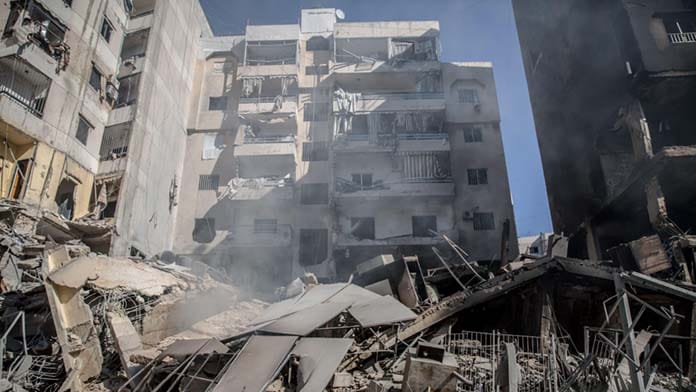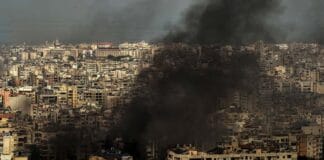Hezbollah emerged as a resistance movement to Israeli occupation and has humbled Israel before but recent years have shown its limitations, argues James Supple
Israel is escalating its war in Lebanon, with brutal bombing raids on civilian areas leaving over 3000 dead and up to a million displaced.
As in Gaza it has deliberately bombed hospitals and targeted ambulance and relief workers, with more than 120 killed so far.
Israel has invaded and occupied Lebanon several times before, leaving thousands of civilians dead and enormous destruction in its wake. But it is also here that it has suffered its first major military defeats.
Israel’s new war is an attempt to reverse its previous failures—in particular its humiliation at the hands of Hezbollah in the 2006 war.
Israel’s political right sees southern Lebanon as territory that should eventually be part of a “Greater Israel”, based on the same expansionist logic that has seen it install settlements in the West Bank. But its immediate aim is to crush resistance in Lebanon similar to its aims in Gaza.
More than 100,000 Palestinian refugees fled to Lebanon during the Nakba in 1948 when Israel was created. By the 1970s, armed Palestinian resistance groups were a significant power in Lebanon, leading to Israeli intervention.
In 1982, Israel launched a devastating invasion, occupying part of Beirut and killing 14,000 Lebanese and Palestinians.
This included organising the massacre of up to 3500 Palestinian refugees—men, women and children—in the Sabra and Shatila refugee camps.
It aimed to crush Palestinian Liberation Organisation (PLO) fighters who were allied with left-wing groups in Lebanon, and to install the Christian Phalange leader Bashir Gemayel in power.
The Palestinian resistance, led by the PLO, was defeated, and forced to evacuate the country.
Israel continued to occupy southern Lebanon for 18 years, arming a local militia group called the South Lebanese Army to help it impose control. It declared the area a “buffer zone” protecting Israel’s northern border.
Hezbollah, the Party of God, emerged as an armed resistance movement against the occupation, based among the Shia Muslim population of southern Lebanon. It drew inspiration, as well as arms and training, from the Islamic regime in Iran that came to power following the Iranian revolution of 1979.
Hezbollah developed deep support among the Shia population, both through providing its own system of welfare, education and health services and through resisting Israel’s occupation.
Israel occupied Lebanese villages and set out to punish the civilian population for attacks on its soldiers with overwhelming force.
In July 1993 it killed 118 civilians in a week of intense bombing. Then in August 1996 it launched another offensive, deliberately shelling a UN facility in Qana serving as a shelter for refugees, massacring 100 civilians.
But Hezbollah attacks kept increasing, killing more and more Israeli soldiers. In 2000 Israel was forced to withdraw from southern Lebanon.
As Israel control collapsed, thousands of Lebanese civilians marched on occupied villages, forcing Israeli and allied troops to flee.
Hezbollah’s standing grew as a result of their victory, winning support across the whole Lebanese nation.
The 2006 war
In 2006 Israel invaded Lebanon again in an effort to crush Hezbollah. It again employed collective punishment of the civilian population to try to force them into submission.
Up to 1300 people were killed and civilian infrastructure including bridges, power stations, sewerage facilities and Beirut’s airport were all targeted.
This became known as the “Dahiya doctrine” after the suburbs of southern Beirut that Israel carpet bombed—just as it is doing again today in its latest assault. The local Shia population were known as strong supporters of Hezbollah.
Israeli General Gadi Eisenkot pledged that the same targeting of civilians would “happen in every village from which Israel is fired on”, with the aim of “harming the population” to turn them against Hezbollah.
Israel’s aim was to kill, maim and terrorise as many civilians as possible, as a warning about the cost of continuing to resist.
But as Lebanese socialist Simon Assaf explained, in 2006, “Despite its savagery, it failed. Instead of intimidating the population, an unprecedented mass movement came to its aid.”
The Shia population of south Beirut were welcomed and given shelter by Christian residents in other parts of the city.
The war ended in humiliation for Israel. It had boasted that its army would win a swift victory against Hezbollah’s guerilla fighters. Instead, “A small band of irregulars kept at bay one of the world’s most powerful armies for over a month, and inflicted remarkable losses on it,” The Guardian’s correspondent David Hirst wrote.
While Israel could bomb Lebanon with impunity, its ground invasion saw its troops falter. Resistance fighters successfully defended local villages, with 50 Israeli soldiers killed in one battle near the village of Aita al-Shabb where the resistance lost just 11 fighters.
Hezbollah’s efforts were celebrated across the whole Middle East, inflicting Israel’s first defeat in a major war since the foundation of the state in 1948. In Lebanon they became national heroes.
This time around Israel has inflicted more severe damage on Hezbollah, assassinating its leader Hassan Nasrullah and other senior figures. Israel has had greater success then before in amassing intelligence on the group, seen in its brutal pager attack.
The damage to communities in Lebanon has also been severe. Yet Israel has also been cautious in sending its troops too far into Lebanon—and Hezbollah is far from defeated.
Class
Recent years have also shown Hezbollah’s political shortcomings. Hezbollah draws funding for its social programs and its weapons from the regimes in Syria and Iran.
This saw Hezbollah send thousands of fighters into Syria against the 2011 popular uprising to defend the dictatorship of Bashar Al-Assad. Like Hezbollah, the Syrian regime is aligned with Iran and its so-called “axis of resistance”.
This shows how Hezbollah is tied into promoting the interests of the ruling classes in Iran and Syria at the expense of ordinary people and any consistent struggle against imperialism.
It has also developed increasing links with wealthy Lebanese Shia donors from inside the country and overseas.
Lebanon is deeply divided along religious and sectarian lines as a result of the political system imposed under French colonial rule in the 1920s. This sees elites among the rival communities—in particular Christians, Sunni and Shia Muslims—compete to parcel out state funding and jobs.
Instead of challenging the sectarian system Hezbollah has helped to entrench it. Since 2005 it has had ministers in several governments and supported waves of austerity measures.
As Assaf puts it, “By joining the government and making political concessions, Hezbollah’s ability to address social and economic questions was constrained, diminishing its potential to become a voice of the poor and to challenge sectarian politicians.”
Several times in recent years workers and ordinary people in Lebanon have staged strikes and mass movements to fight against poverty and neoliberalism—with Hezbollah on the wrong side.
In 2012 electricity workers went on strike for 94 days to demand permanent jobs and an end to temporary contracts. In 2013 and 2014 teachers took weeks of strike action to demand pay rises.
In 2019 Lebanon exploded in its “October revolution”, after the government tried to impose a tax on WhatsApp calls.
This was a mass movement that spread across the country, uniting ordinary people across sectarian divisions against the country’s elites, branding “All of them” responsible for the country’s crippling economic crisis.
Weeks of road blockades and strikes forced the prime minister to resign and the dumping of the new tax.
But Hezbollah was part of the government and opposed the protests, even beating up protesters, burning down tents and trashing cars.
The revolt showed how class struggle can break down Lebanon’s sectarian divide and win gains for workers and the poor. The struggle points to a strategy of resistance that goes beyond Hezbollah’s limitations.
The country remains in a severe economic crisis following a currency and debt crisis, with about 80 per cent of the population below the poverty line. But there are still six billionaires with a combined wealth of $11.8 billion.
Israel won’t break Lebanon’s resistance, but Hezbollah’s missiles cannot defeat Israel militarily.
Resistance to imperialism and Israel’s total war has to be a project of revolution in Lebanon and the region.
Socialist politics based on building the struggle from below is the way to both fight poverty and imperialism.
Supporting Hezbollah is no crime
Hezbollah’s listing as a terrorist organisation by the Australian government is an act of gross hypocrisy. It means the display of Hezbollah symbols and flags carries the risk of arrest. Police in Sydney have charged a 19-year-old woman with waving a Hezbollah flag at a rally in October.
Israel’s terror has murdered as many as 200,000 Palestinians in Gaza and thousands more in Lebanon, yet there is no sanction on waving Israeli flags or raising funds for Israel.
Australian citizens are even allowed to travel and fight with the Israeli Defence Forces as they carry out systematic and repeated war crimes. Anthony Albanese describes Israel as “our friend”.
Hezbollah should be removed from the terrorist list. It is being demonised simply because it opposes US imperialism and Israel’s occupation of Palestine. But it is a mass political force in Lebanon representing the Shia population, with 15 seats in parliament and ministers in previous governments.
In the face of Israel’s invasion and ruthless bombing of Lebanon, Hezbollah and the Lebanese population have a right to resist.




